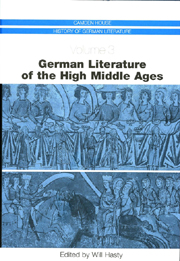Book contents
- Frontmatter
- Contents
- List of Illustrations
- Acknowledgments
- Introduction
- Part I The First Flourishing of German Literature
- Part II Lyric and Narrative Traditions
- Part III Continuity, Transformation, and Innovation in the Thirteenth Century
- Wirnt von Gravenberg's Wigalois and Heinrich von dem Türlin's Diu Crône
- Der Stricker
- Rudolf von Ems
- Ulrich von Liechtenstein
- Konrad von Würzburg
- Wernher der Gärtner
- Part IV Historical Perspectives
- Bibliography
- Notes on the Contributors
- Index
Wernher der Gärtner
from Part III - Continuity, Transformation, and Innovation in the Thirteenth Century
Published online by Cambridge University Press: 05 February 2013
- Frontmatter
- Contents
- List of Illustrations
- Acknowledgments
- Introduction
- Part I The First Flourishing of German Literature
- Part II Lyric and Narrative Traditions
- Part III Continuity, Transformation, and Innovation in the Thirteenth Century
- Wirnt von Gravenberg's Wigalois and Heinrich von dem Türlin's Diu Crône
- Der Stricker
- Rudolf von Ems
- Ulrich von Liechtenstein
- Konrad von Würzburg
- Wernher der Gärtner
- Part IV Historical Perspectives
- Bibliography
- Notes on the Contributors
- Index
Summary
HISTORICAL SOURCES REVEAL NOTHING ABOUT Wernher der Gärtner, author of the short verse narrative Helmbrecht. It is therefore difficult to know exactly when and where he lived and what his social status may have been. Some biographical information can be reconstructed on the basis of his work. We know the name of the poet from the final lines of Helmbrecht, in which he asks his audience to include him in their prayers:
Swer iu ditze mære lese,
bitet daz im got genædec wese
und dem tihtære,
Wernher dem Gartenære. (1931–34)
[Whoever might read this tale to you, pray that God will bestow His grace upon him and upon the poet Wernher der Gärtner.]
There are several unsuccessful attempts to understand what the name Gartenære may say about the poet. The possibilities extend from the derivation of a place name, to a family name and, finally, to a metaphoric expression of Wernher's profession (that is, one who toils in the “garden” of poetry). It is unlikely that Wernher was a cleric, because of a passage in Helmbrecht that suggests his life involved wandering:
swie vil ich var enwadele,
sô bin ich an deheiner stete,
dâ man mir tuo, als man im [Helmbrecht] tete. (848–50)
[However much I travel here and there, I never find myself in a place where I am treated as well as he was.]
- Type
- Chapter
- Information
- German Literature of the High Middle Ages , pp. 255 - 260Publisher: Boydell & BrewerPrint publication year: 2006



